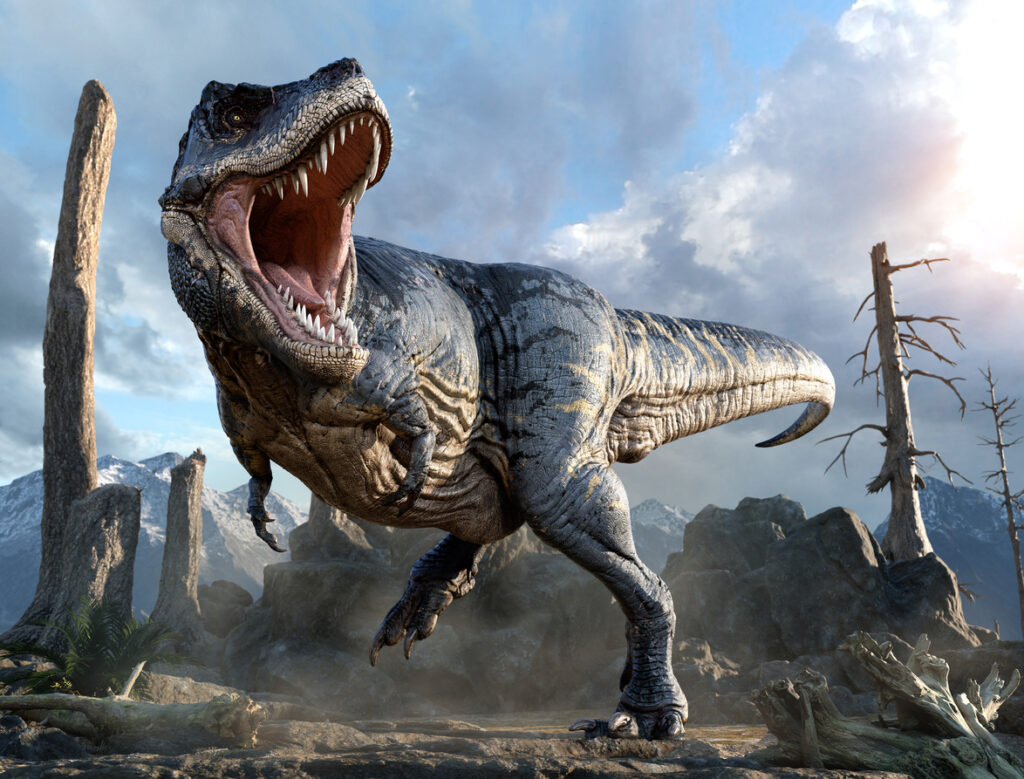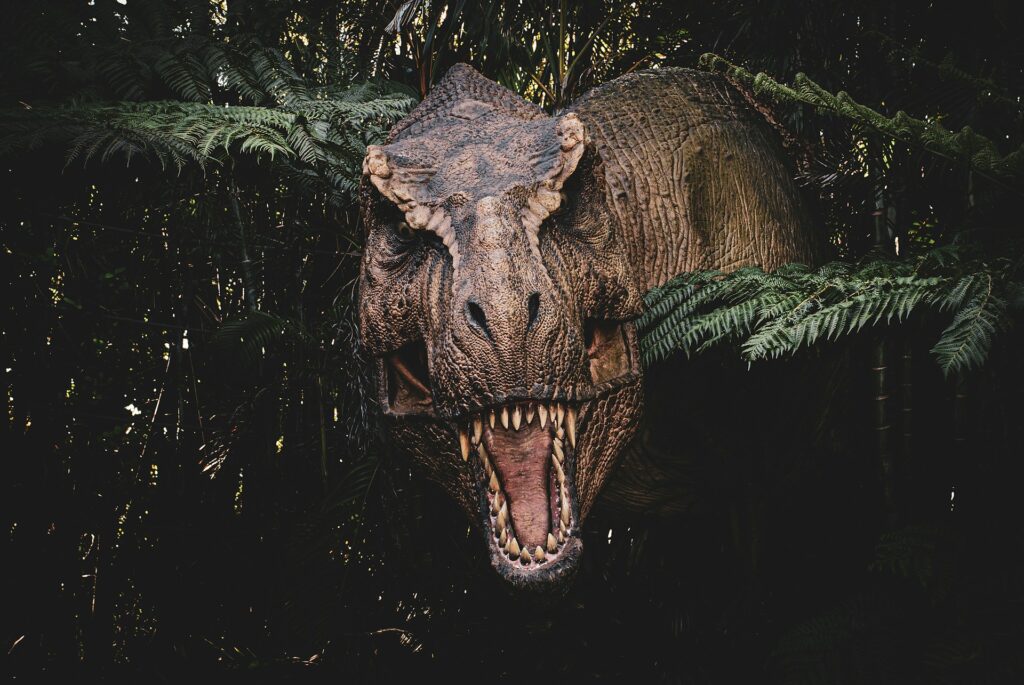
Thanks to pop culture, the Tyrannosaurus rex has become the poster child for prehistoric terror. With its massive skull, bone-crushing bite, and starring role in practically every dinosaur movie ever made, it’s easy to assume the T. rex was the undisputed king of the dino world. But when you dig into the science—beyond the CGI roars and dramatic chase scenes—you’ll find that the T. rex might’ve been tough, but it wasn’t the fiercest. Not by a long shot.
From speed and agility to sheer brutality, there were other dinosaurs that gave the T. rex a serious run for its money. Some were faster, some were sneakier, and others were just plain meaner. So if you’ve always pictured T. rex as the ultimate apex predator, it might be time to rethink that. Here’s why the crown of “fiercest dinosaur” might actually belong to someone else.
The T. rex might have been a scavenger.
There’s a long-standing theory that the T. rex wasn’t always the bold hunter we imagine—it may have scavenged more than it hunted. Its keen sense of smell and strong legs made it great at sniffing out carcasses, and it had no problem muscling in on another predator’s kill.
That doesn’t make it weak, but it does make it more opportunistic than ferocious. In the wild, survival matters more than style points, but if we’re talking pure aggression and hunt-to-kill behaviour, other dinosaurs may have fit the role better.
The Giganotosaurus was bigger.
If size alone were the measure of fierceness, the Giganotosaurus has a pretty solid claim to the title. This massive predator, found in what’s now Argentina, was likely even longer than the T. rex, stretching up to 40 feet. That’s a lot of lizard.
Giganotosaurus may not have had quite the bite force of T. rex, but its sheer size and speed made it a terrifying predator in its own right. It hunted in open plains, likely going after massive prey like titanosaurs—and it did so with a mouth full of blade-like teeth built for slicing, not crushing.
The Spinosaurus was a semi-aquatic nightmare.
T. rex ruled the land, but Spinosaurus was terrifying both in and out of the water. It was even longer than T. rex and had a crocodile-like snout full of conical teeth—perfect for gripping slippery fish or lunging at smaller dinosaurs near riverbanks.
Its unique body plan, with paddle-like feet and a massive sail along its back, makes it one of the strangest and most specialised predators of the Cretaceous. If you were near a river or swamp, T. rex was the least of your worries—Spinosaurus was the real threat.
Velociraptors were small but savage.
They weren’t the human-sized horrors seen in Jurassic Park, but actual Velociraptors were still deadly in their own right. About the size of a turkey, these predators hunted in packs and used their sharp claws and intelligence to bring down prey much larger than themselves.
Their speed, coordination, and agility made them efficient killers. They relied less on brute force and more on strategy—something the T. rex didn’t quite master. Fierce doesn’t always mean big; sometimes it means smart and scrappy.
The Allosaurus was a relentless pack hunter.
Allosaurus was around long before T. rex, but it brought serious carnivore energy to the Jurassic period. This predator likely hunted in packs and used its sharp, serrated teeth to deliver repeated slashing bites that caused its prey to bleed out over time.
Unlike the bone-crunching ambush strategy of T. rex, Allosaurus relied on endurance and teamwork. Its neck and jaw structure allowed for swift, repetitive strikes—like the horror-movie version of death by a thousand cuts.

T. rex had competition in its own backyard.
Even in North America, T. rex wasn’t alone. Smaller but faster predators like the Dakotaraptor or the more agile Albertosaurus shared the same ecosystems. These dinosaurs weren’t as massive, but they were nimble, clever, and often hunted in groups.
That meant T. rex couldn’t always bully its way to a meal. It had to deal with competition from faster, sharper predators that could outmanoeuvre it. Being at the top of the food chain doesn’t mean being alone on it.
Its arms were almost comically small.
Let’s talk about the elephant—or rather, the arms—in the room. T. rex’s arms were tiny. So tiny, in fact, that it couldn’t really use them to grab, slash, or hold onto prey. Scientists still debate what those stubby limbs were even for, but one thing’s clear—they weren’t contributing much to the whole “ferocious predator” image.
Meanwhile, other theropods like the Therizinosaurus evolved giant claws, and even smaller raptors had more functional upper limbs. T. rex made do with its bite, sure—but its design wasn’t exactly well-rounded.
It wasn’t the fastest predator on two legs.
Despite its powerful legs, T. rex likely wasn’t built for sprinting. Most estimates put its top speed at around 12–20 mph. That’s decent, but not exactly fearsome when you consider smaller predators could outrun it with ease.
Its body was heavy, and its massive tail helped with balance more than speed. So if your survival depended on running away from a T. rex… you actually had a fighting chance. Not something you could say about every dinosaur.
It needed good timing to win fights.
One of the theories about T. rex’s hunting style is that it was an ambush predator—using its strong bite to end things quickly. But that also meant it needed to get the timing right. If it missed its chance or miscalculated, it wasn’t very good at chasing down prey for a second go.
Other predators had claws, speed, or pack tactics to back them up. T. rex was more of a “go big or go home” kind of hunter. When it worked, it worked. But when it didn’t? It probably had to wait for something slower to come along.
Even its name is a bit of an overstatement.
“Tyrant lizard king” is definitely a cool name, but it might’ve been more about its size and skull than its actual behaviour. T. rex certainly ruled pop culture and late Cretaceous North America—but worldwide, it wasn’t the biggest, the fastest, or the most creative predator out there.
Sometimes the fiercest creatures aren’t the ones with the biggest jaws—they’re the ones that adapt, collaborate, or creep in where you least expect them. And in that sense, T. rex might’ve just been the loudest, not the scariest.